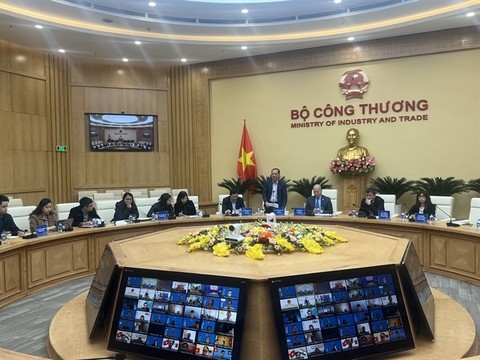
A monthly meeting of Trade Promotion Agency with its Vietnam Trade Office system abroad is held by the agency in Hà Nội on February 29. — VNS Photo Hoàng Hà
As demand for rice imports in many markets increases, along with prices also, Vietnamese rice exporters need to take full opportunities to promote rice exports.
To do that, businesses must firmly grasp information and ensure rice supply.
Those were the main contents discussed at the monthly meeting of the Trade Promotion Agency, the Ministry of Industry and Trade (MoIT), with its Vietnam Trade Office system abroad held by the agency in Hà Nội on February 29.
Trần Quốc Toản, deputy director of MoIT's Import-Export Department, said that agricultural exports, including rice, have seen positive signals since the beginning of this year.
According to the General Statistics Office, as of February 15, Việt Nam's rice exports reached 663,209 tonnes, earning $466.6 million. The exports increased by 14.4 per cent in volume and 53 per cent in value compared to the same period in 2023.
Meanwhile, the average rice export price was at $703.5 per tonne, up by 33.65 per cent over the same period in 2023.
Experts predict that the rice import demand of many countries will tend to increase in 2024, including Việt Nam's largest rice export markets such as the Philippines, Indonesia and China, according to the Import and Export Department. Because global rice trade continues to be affected by India's policy of temporarily suspending rice exports.
Along with that, the global rice supply is forecast to be lower as the main supply from India, accounting for 40 per cent of the global output, will decrease by 4 million tonnes compared to the previous year to 132 million tonnes. Other suppliers such as Thailand and Cambodia, are also forecast to reduce rice output due to the impact of the El Nino phenomenon and climate change.
At the same time, global ending inventories for the 2023-2024 crop year are forecast at 167.2 million tonnes, down 8.6 million tonnes compared to the previous crop year, the lowest inventory in the past six years.
In addition, the department said that Việt Nam also has advantages from free trade agreements with its partners such as the EU, South Korea and Japan, to boost rice exports. While, other great potential markets such as the US and Middle Eastern countries, are also showing positive signs.
To take the opportunities to maintain rice exports to traditional markets and to also enter the potential markets, MoIT has been implementing key solutions, including coordination with the Ministry of Foreign Affairs and the Ministry of Agriculture and Rural Development in diversifying export markets, increasing market shares in new export markets, and enhancing competitiveness for Vietnam's rice industry, according to Toản.
The ministry also continues to closely monitor the situation of the world rice trade market, as well as the moves of major rice-producing and exporting countries. Then, it will provide market information to other ministries, sectors, the Vietnam Food Association, traders and exporters to proactively regulate rice production and business.
The trade promotion agency continues to have flexibility in the organisation of trade promotion activities, combining traditional and online forms, to strengthen rice trading activities with traditional markets such as Indonesia, China and Africa.
Việt Nam will also continue to boost exports of fragrant rice and high-quality rice to the EU, South Korea and North America.
MoIT will carry out Việt Nam's rice export market development strategy until 2030. At the same time, it supports for rice traders to improve production and business capacity, and to have more market information, and experience in negotiation, signing and implementation of export contracts. It will also help businesses solve international trade disputes.
Nguyễn Ngọc Nam, Chairman of the Việt Nam Food Association, proposed that MoIT should quickly provide up-to-date information on export and import data of countries, thereby helping businesses proactively have rice export plans.
At the same time, the ministry needs to raise businesses' awareness in meeting the standards of export markets.
MoIT recommends that the association provides information about FTAs for the businesses, helping them improve processing and production capacity to meet market requirements, Toản said.
Vũ Bá Phú, director of the Trade Promotion Agency, also noted that the trade offices, have monthly reports on the rice market situation and the management of rice products in the host country, thereby helping the agency provide timely support to localities in rice production and business.
In 2023, Việt Nam's rice exports reached 8.1 million tonnes, worth $4.68 billion, up 14.4 per cent and 35.3 per cent respectively, compared to the previous year.
Of which, Việt Nam's largest rice export market was ASEAN, accounting for 61 per cent of the country's total rice exports with 4.9 million tonnes, an increase of 24 per cent over the previous year. — VNS